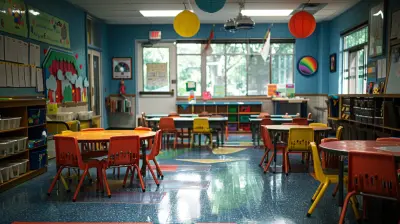Unlocking Student Potential: Proven Teaching Strategies for Every Classroom
19 May 2025
Education is the foundation of a thriving society. As teachers, we're given the responsibility of shaping young minds and unlocking the potential that every student carries. But let's be real for a moment – teaching is no walk in the park. Every classroom is a diverse mix of personalities, learning styles, and challenges. So, how do we tap into each student's unique potential and create an environment where everyone can thrive?
In this article, we'll dive into several proven teaching strategies that can help you unlock the potential of your students. These strategies have been tried and tested in classrooms around the world, and they aim to make learning engaging, effective, and inclusive for all. Ready to explore? Let’s get started!

Why Is Unlocking Student Potential So Important?
Before we jump into the strategies, let’s address the elephant in the room: why does unlocking student potential even matter?Well, think about it like this: students are like seeds. Every seed has the potential to grow into a magnificent tree, but without the right care and nurture, that potential remains untapped. As educators, we hold the water, sunlight, and nutrients that can help these seeds grow. But here’s the catch – not every seed needs the same amount of water or sunlight. Some will thrive with a little extra attention, while others need space to grow at their own pace.
By unlocking student potential, we’re not only creating better learners, but we’re also fostering future innovators, leaders, and problem-solvers. And who wouldn’t want to be a part of that?

1. Differentiated Instruction: One Size Doesn’t Fit All
Let’s kick things off with a strategy that has gained a lot of attention: differentiated instruction. This approach is based on the idea that no two students are the same. They have different backgrounds, skills, and ways of processing information. So, why should we teach them all the same way?With differentiated instruction, you tailor your teaching methods to meet the diverse needs of your students. This means providing different avenues for students to explore content, express what they’ve learned, and engage with the material. For example, some students might thrive with hands-on activities, while others may prefer reading or watching videos.
How to Implement Differentiated Instruction:
- Tiered assignments: Give students tasks based on their skill level, but keep the core concept the same for everyone.- Flexible grouping: Allow students to work in various groups depending on their strengths and weaknesses.
- Multiple assessment types: Use a range of assessments (written, oral, project-based) to gauge understanding.
By embracing differentiated instruction, you’re acknowledging that every student learns differently – and that’s a game-changer in the classroom.

2. Growth Mindset: Fostering a Love for Learning
Ever heard the saying, “Whether you think you can or you think you can’t, you’re right”? That’s the essence of the growth mindset – a concept popularized by psychologist Carol Dweck. It’s all about teaching students that their abilities aren’t fixed and that they can improve with effort and perseverance.Students with a growth mindset are more willing to take on challenges and learn from their mistakes. They’re less likely to give up when things get tough, and they’re more open to feedback. On the flip side, students with a fixed mindset believe that their intelligence is set in stone, which can lead to a fear of failure and a reluctance to try new things.
How to Cultivate a Growth Mindset:
- Praise the process, not the outcome: Instead of saying, “You’re so smart,” say, “I’m proud of how hard you worked on this.”- Encourage risk-taking: Let students know that failure is a stepping stone to success.
- Teach metacognitive skills: Help students reflect on their learning process and think about how they can improve.
By fostering a growth mindset, you’re helping students see that their potential is limitless, as long as they’re willing to put in the effort.

3. Active Learning: Engaging Students in the Process
We’ve all had those moments in class where students just seem to be zoning out. They’re physically present, but mentally? Not so much. That’s where active learning comes in.Active learning is all about getting students involved in the learning process. Instead of passively absorbing information, students engage with the material through discussions, problem-solving, and hands-on activities. It’s like the difference between watching someone else cook a meal and actually getting your hands dirty in the kitchen.
Examples of Active Learning Techniques:
- Think-pair-share: Pose a question, let students think about it individually, discuss with a partner, and then share with the class.- Case studies: Present real-world problems and have students work in groups to solve them.
- Interactive simulations: Use technology to simulate different scenarios (like virtual labs or historical events) for students to interact with.
By making learning more interactive and engaging, you're not just teaching content – you're involving students in the process, which leads to deeper understanding and retention.
4. Formative Assessment: Feedback That Drives Improvement
Imagine playing a video game where you only find out how well you did after beating the final boss. Pretty frustrating, right? That’s how students feel when they only get feedback at the end of a unit or term. Formative assessment is the antidote to this problem.Formative assessments are ongoing assessments that provide feedback during the learning process, not just at the end. It’s like a GPS system for learning – it lets students know where they are, where they need to go, and how to get there.
How to Use Formative Assessment:
- Exit tickets: At the end of a lesson, ask students to write down one thing they learned and one question they still have.- Quizzes: Use quick, low-stakes quizzes to check for understanding.
- Peer review: Have students give each other feedback on their work before submitting it.
Formative assessment helps students stay on track and gives you valuable insights into what’s working and what needs adjustment.
5. Positive Classroom Environment: Building Relationships and Trust
Let’s face it – students are more likely to thrive in environments where they feel safe, supported, and respected. A positive classroom environment is key to unlocking student potential because it sets the stage for meaningful learning.When students feel valued and understood, they’re more likely to take risks, ask questions, and engage in the material. But creating a positive environment isn’t just about being “nice.” It’s about building relationships, fostering trust, and setting clear expectations.
Ways to Foster a Positive Classroom Environment:
- Establish clear rules and routines: Students thrive when they know what’s expected of them.- Get to know your students: Take time to learn about their interests, strengths, and challenges.
- Celebrate successes: Whether big or small, celebrate student achievements to boost morale.
By creating a classroom where students feel seen and heard, you’re paving the way for them to reach their full potential.
6. Scaffolded Learning: Providing Support Until They’re Ready
Have you ever tried to build a house without a solid foundation? Probably not, because it would collapse. The same applies to learning. Scaffolding is a teaching strategy that involves providing students with temporary support as they build their skills and knowledge. Once they’ve developed enough understanding, you gradually remove the support, allowing them to stand on their own.Scaffolding gives students the structure they need to tackle complex tasks without feeling overwhelmed.
Scaffolding Techniques:
- Break tasks into smaller steps: Guide students through each step before moving on to the next.- Model the process: Demonstrate how to complete a task or solve a problem before asking students to do it on their own.
- Use prompts and cues: Provide hints or guiding questions to help students think through challenges.
By scaffolding learning, you’re giving students the confidence and tools they need to succeed independently.
7. Incorporating Technology: Leveraging Tools for Learning
We live in a digital age, and today’s students are more tech-savvy than ever. So, why not leverage technology to enhance learning? Incorporating technology into the classroom can open up a world of possibilities, from personalized learning experiences to interactive lessons.Technology allows students to explore content at their own pace, access a wide range of resources, and collaborate with peers in new ways.
How to Use Technology in the Classroom:
- Flipped classrooms: Provide video lectures for students to watch at home, so class time can be spent on interactive activities.- Educational apps: Use apps and platforms that offer personalized learning experiences (e.g., Khan Academy, Google Classroom).
- Virtual field trips: Take students on virtual tours of historical sites, museums, or even the solar system!
By incorporating technology, you’re not only keeping students engaged but also preparing them for the digital world they’ll navigate in the future.
Conclusion: The Power of a Well-Rounded Approach
Unlocking student potential isn’t about finding a one-size-fits-all solution. It’s about understanding that each student is unique and requires a tailored approach. By implementing a combination of differentiated instruction, fostering a growth mindset, incorporating active learning, and creating a positive classroom environment, you can help every student in your classroom reach new heights.Remember, teaching is both an art and a science. It’s about finding the right balance of strategies that work for you and your students. And with these proven techniques in your toolkit, you’re well on your way to unlocking the full potential of every student who walks through your door.
all images in this post were generated using AI tools
Category:
Teaching StrategiesAuthor:

Eva Barker
Discussion
rate this article
3 comments
Mabel Thomas
Great insights! These proven strategies provide valuable guidance for educators looking to enhance student engagement and success.
June 8, 2025 at 11:46 AM

Eva Barker
Thank you! I'm glad you found the strategies helpful for enhancing student engagement and success.
Greta Larsen
Empowering students requires tailored strategies; every learner’s journey is unique and deserves personalized guidance.
May 31, 2025 at 4:11 AM

Eva Barker
Absolutely! Personalizing education is key to unlocking each student's potential and fostering their unique learning journey.
Zylith McCallum
I'm intrigued by the idea of unlocking student potential! What innovative strategies have proven most effective in diverse classrooms, and how can we adapt them for different learning styles?
May 28, 2025 at 3:02 AM

Eva Barker
Thank you for your interest! Effective strategies include differentiated instruction, collaborative learning, and the use of technology. Tailoring these methods to accommodate visual, auditory, and kinesthetic learners can significantly enhance engagement and outcomes in diverse classrooms.



